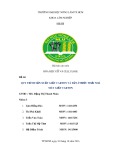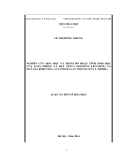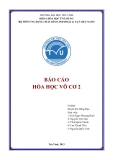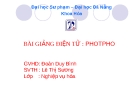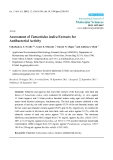Hindawi Publishing Corporation EURASIP Journal on Image and Video Processing Volume 2008, Article ID 860743, 10 pages doi:10.1155/2008/860743
Research Article Unsupervised Video Shot Detection Using Clustering Ensemble with a Color Global Scale-Invariant Feature Transform Descriptor
Yuchou Chang,1 D. J. Lee,1 Yi Hong,2 and James Archibald1
1 Electrical and Computer Engineering Department, Brigham Young University, Provo, UT 84602, USA 2 Department of Computer Science, City University of Hong Kong, Kowloon, Hong Kong
Correspondence should be addressed to D. J. Lee, djlee@ee.byu.edu
Received 1 August 2007; Revised 30 October 2007; Accepted 22 November 2007
Recommended by Alain Tremeau
Scale-invariant feature transform (SIFT) transforms a grayscale image into scale-invariant coordinates of local features that are invariant to image scale, rotation, and changing viewpoints. Because of its scale-invariant properties, SIFT has been successfully used for object recognition and content-based image retrieval. The biggest drawback of SIFT is that it uses only grayscale informa- tion and misses important visual information regarding color. In this paper, we present the development of a novel color feature extraction algorithm that addresses this problem, and we also propose a new clustering strategy using clustering ensembles for video shot detection. Based on Fibonacci lattice-quantization, we develop a novel color global scale-invariant feature transform (CGSIFT) for better description of color contents in video frames for video shot detection. CGSIFT first quantizes a color image, representing it with a small number of color indices, and then uses SIFT to extract features from the quantized color index image. We also develop a new space description method using small image regions to represent global color features as the second step of CGSIFT. Clustering ensembles focusing on knowledge reuse are then applied to obtain better clustering results than using single clustering methods for video shot detection. Evaluation of the proposed feature extraction algorithm and the new clustering strat- egy using clustering ensembles reveals very promising results for video shot detection.
Copyright © 2008 Yuchou Chang et al. This is an open access article distributed under the Creative Commons Attribution License, which permits unrestricted use, distribution, and reproduction in any medium, provided the original work is properly cited.
1.
INTRODUCTION
tics-based, and transform-based methods [2]. In this pa- per, we focus on clustering-based shot detection [3–14] which can be considered as a combination of feature-based and statistics-based methods. Different clustering algorithms such as hierarchical clustering [4, 10], k-means [5, 13], self-organizing map (SOM) [7], fuzzy c-means [8, 11], co- occurrence matrix [9], information-theoretic coclustering [12], and other clustering methods [3, 6, 14] have been used for shot detection in recent years.
The recent rapid growth of multimedia databases and the in- creasing demand to provide online access to these databases have brought content-based video retrieval (CBVR) to the attention of many researchers. Because manual indexing of archived videos is infeasible due to prohibitively high la- bor costs, automatic video retrieval is essential to the on- line accessing of multimedia databases. Generally, video con- tent can be represented by a hierarchical tree which contains shots, scenes, and events [1]. A continuous video bitstream is segmented into a series of cascaded video shots, which are the basis for constructing high-level scenes and events with semantic meanings. Hence, shot detection [2], the identifi- cation of a continuously recorded sequence of image frames, is critical for semantic analysis of video content.
Berkhin [15] classified clustering algorithms into 8 groups, for example, hierarchical methods, partitioning me- thods, grid-based methods, constraint-based clustering, and so forth. Generally, clustering-based shot detection methods use just a single clustering algorithm to categorize frames into corresponding shots. Each clustering method has its own advantages and disadvantages that result in different performance over different data sets, so no single method is consistently the best. Considering the success of clustering
Shot detection can generally be categorized into five classes: pixel-based, histogram-based, feature-based, statis-
2
EURASIP Journal on Image and Video Processing
localization, orientation assignment, and keypoint descrip- tor assignment.
ensembles [16–19] in machine learning in recent years, we propose a novel clustering strategy using clustering ensem- bles for shot detection.
However, as previously noted, SIFT features are generally derived from grayscale images. With the development and advancements in multimedia technologies, the bulk of video data of interest is in color. Color images contain more vi- sual information than grayscale. For SIFT feature extraction, video data must be converted to grayscale, causing impor- tant visual information to be lost. In order to describe color video contents as accurately as possible, we use a quantiza- tion method based on Fibonacci lattices [25] to convert the color image into color indices for SIFT. Furthermore, because SIFT extracts only local features and cannot describe global context for visual content analysis, a new feature-extraction algorithm designed to address the color video shot detection problem would be very useful. We propose such a technique: color global scale-invariant feature transform (CGSIFT).
2.2. Clustering ensemble
Features that help the user or machine judge if a particu- lar frame is contained within a shot are critical for shot detec- tion. Many visual features have been proposed for describing the content of the image [24]. Scale-invariant feature trans- form (SIFT) has been shown to be the most robust, invariant descriptor of local features [20–23]. However, SIFT operates on grayscale images rather than the color images that make up the vast majority of recorded videos. SIFT uses a one- dimensional (1D) vector of scalar values for each pixel as a local feature descriptor and cannot be extended to operate on color images which generally consist of three-dimensional (3D) vector values. The main difficulty of applying SIFT to color images is that no color space is able to use 1D scalar val- ues to represent colors. Although there are many color space conversion methods that transform 3D RGB color values to other color spaces such as HSV and CIE Lab, the transformed color spaces still represent colors in 3D.
Methods based on clustering ensembles have been shown to be effective in improving the robustness and stability of clustering algorithms [16–19]. Classical clustering ensemble methods take multiple clusters into consideration by em- ploying the following steps. First, a population of clusters is obtained by executing different clustering algorithms on the same data set. Second, an ensemble committee is con- structed from all resulting clusters. Third, a consensus func- tion is adopted to combine all clusters of the ensemble com- mittee to obtain the final clusters.
In order to use SIFT for color video shot detection, each color video frame must be converted into color indices to represent a small set of important colors present in the frame. SIFT can then be applied to the color indices which are treated as gray-level values in grayscale images for fea- ture extraction. We adopt a very powerful color quantization method called Fibonacci lattice-quantization [25] to quan- tize color information and generate a palette of color in- dices for SIFT. Based on this approach, we propose a novel color feature descriptor using the global context of the video frame. This new color feature descriptor, based on SIFT, is called the color global scale-invariant feature transform (CGSIFT) descriptor. We then apply clustering ensembles to the new CGSIFT descriptor to detect shots in color video.
Figure 1 shows the framework of a classical clustering en- semble method. By leveraging the consensus across multi- ple clusters, clustering ensembles give a generic knowledge framework for combining multiple clusters. Two factors cru- cial to the success of any clustering ensemble are the follow- ing:
(i) the construction of an accurate and diverse ensemble
committee of diverse clusters;
(ii) the design of an appropriate consensus function to combine the results of the ensemble committee.
The rest of this paper is organized as follows. Section 2 describes background work related to SIFT and clustering ensembles. Section 3 introduces the new CGSIFT for color feature extraction based on SIFT. Shot detection structure based on clustering ensembles is presented in Section 4. Section 5 discusses processing time and storage space anal- ysis to illustrate the advantages of the proposed method. Experimental results are presented in Section 6 to evaluate the performance of the proposed method based on the new feature descriptor and clustering ensembles. Section 7 con- cludes this work.
2. RELEVANT WORK
2.1. Scale-invariant feature transform
Strehl and Ghosh [16] introduced the clustering ensem- ble problem and provided three effective and efficient al- gorithms to address the problem: cluster-based similarity partitioning algorithm (CSPA), hypergraph partitioning al- gorithm (HGPA), and meta-clustering algorithm (MCLA). In order to benefit from the clustering ensemble approach, objects should be represented using different features. The number and/or location of initial cluster centers in iterative algorithms such as k-means can be varied. The order of data presentation in on-line methods such as BIRCH [27] can be varied. A portfolio of very different clustering algorithms can be jointly used. The experiments of Strehl and Ghosh show that clustering ensembles can be used to develop robust, su- perlinear clustering algorithms and to dramatically improve sets of subspace clusterings for different research domains.
Topchy et al. [17] extended clustering ensemble research in several regards. They introduced a unified representation for multiple clusterings and formulated the corresponding
SIFT is a computer vision algorithm that extracts distinc- tive features from an image. It was originally used for object recognition [20, 22] and later applied to content-based image retrieval [23]. Features extracted by SIFT are invariant to im- age scale, rotation, and changing viewpoints. The algorithm transforms a grayscale image into scale-invariant coordinates of local features, which are the keypoints of the image. Each keypoint is represented by a 128-dimension vector. SIFT con- sists of 4 steps [20]: scale-space extrema detection, keypoint
Yuchou Chang et al.
3
· · ·
89 Data set 76 81 68 84 55 63 60 47 73 42 71 34 50 86 39 52 29 26 21 58 65 37 79 13 31 18 16 Clustering Clustering Clustering 78 8 44 45 24 5 66 10 57 23 3 11 87 32 Clustering partition 1 Clustering partition 2 Clustering partition M 36 2 0 53 19 15 70 1 6 74 49 7 40 28 4 27 14 83 61 20 9 12 62 Ensemble committee 41 48 22 35 17 82 33 25 54 75 69 30 46 56 43 38 67 88 51 59 77 64 80 72 Final partition 85
Figure 2: Points of the Fibonacci lattice in a complex plane.
Figure 1: Framework of classical clustering ensemble.
categorical clustering problem. They proposed a probabilis- tic model of the consensus function using a finite mixture of multinomial distributions in a space of clusterings. They also demonstrated the efficiency of combining partitions gener- ated by weak clustering algorithms that use data projections and random data splits.
Color quantization [26] is a sampling process of 3D color spaces (RGB, CIE Lab, HSV, etc.) to form a subset of colors known as the palette which are then used to represent the original color image. Color quantization is particularly con- venient for color image compression, transmission, and dis- play. Unlike most color quantization methods that generate a color palette with three separate color components for each color in the selected subset, quantization using Fibonacci lat- tices denotes colors using single scalar values. These scalar values can be used to denote visual “distance” between their corresponding colors. However, traditional color quantiza- tion algorithms such as uniform [29], median cut [29], and Octree [30] use palette indices only to point to the stored, quantized 3D color values. Attributes of this new quantiza- tion method are very useful for our application: we use Fi- bonacci lattice-quantization to convert colors into 256 scalar color indices and then use these indices to construct SIFT.
Fred and Jain [18], based on the idea of evidence accu- mulation, considered that each partition is viewed as an inde- pendent evidence of data organization. Individual data par- titions are combined based on a voting mechanism to gen- erate a new n × n similarity matrix for n patterns. The final data partition of these n patterns is obtained by applying a hierarchical agglomerative clustering algorithm on this ma- trix. Kuncheva and Vetrov [19] used standard k-means that started from a random initialization to evaluate the stabil- ity of a clustering ensemble. From their experimental results they concluded that ensembles are generally more stable than single component clustering.
Clustering ensembles have demonstrated stable and ac- curate clustering results through a large number of experi- ments on real and synthetic data in the literature. We employ them here to group color video shots based on the features detected by our CGSIFT algorithm.
The Fibonacci lattice sampling scheme proposed in [25] provides a uniform quantization of CIE Lab color space and a way to establish a partial order relation on the set of points. For each different L value in CIE Lab color space, a complex plane in polar coordinates is used to define a spiral lattice as a convenient means for sampling. The following set of points in the (a, b) plane constitutes a spiral lattice:
3. FEATURE EXTRACTION USING CGSIFT
(1)
τ, δ ∈ R, n ∈ Z.
zn = nδe j2π·nτ,
3.1. Retain color information by
√
Fibonacci lattice- quantization
Figure 2 shows an example of the spiral, Fibonacci lattice 5 − 1)/2 and δ = 1/2. Each point zn is identified for τ = ( by its index n. Parameters τ and δ determine the axial distri- bution and the radial distribution of the points, respectively. If there exist NL luminance (L) values and Np colors in the corresponding (a, b) plane, for each color in the palette, the corresponding symbol is determined by adding its chromi- nance index n to a multiple of its luminance index i:
(2)
24-bit color images have three color components: red, green, and blue, which are combined to generate over 16 million unique colors. Compared to a 256 grayscale image, a color image can convey much more visual information, providing the human perceptual system with much more details about the scene. However, not all 16 million colors are distinguish- able by humans, particularly if colors are very similar.
q = n + Np·i.
4
EURASIP Journal on Image and Video Processing
= a2
p + b2 p.
√
global features. Assume that, after performing SIFT based on Fibonacci lattice-quantization, one image has NI keypoints, each of which is a 128-dimension vector. We construct a tem- plate shown in Figure 4 to gather position information for constructing CGSIFT. This template consists of 24 distinct regions that increase in size as their distance from the cen- ter of the image increases. Generally, objects in the center of an image attract more attention than surrounding objects, which are often considered to be background or other triv- ial details. For example, in Figure 3, the vehicles are the main focus in the frame, and the trees and ground are background and relatively unimportant. Hence, smaller regions in the center part tend to describe more important contents, and larger regions on the periphery tend to depict less important details.
√
We give each region an order label to distinguish the par- titions. The eight regions nearest the center are labeled as 1 to 8, the eight intermediate regions are 9 to 16, and outer- most regions are 17 to 24. In each region, a mean color value is calculated based on the symbol q of each pixel within the region as follows:
Consequently, the L, a, and b values for any color from the palette can be reconstructed from its symbol q. For a pixel p, with color components Lp, ap, and bp, the process of deter- mining the closest palette point starts with finding the closest luminance level LS from the NL levels available in the palette. The luminance level LS determines an (a, b) plane and one of the points zn, 0 ≤ n ≤ Np, in that plane is the minimum mean square error (MSE) solution. The exact solution, q, is the point whose squared distance to the origin is the closest to r2 p These L values can approximately denote the luminance levels of the image. Since the (a, b) plane is not circular, there will be points in the Fibonacci lattice whose colors are not valid in RGB color space. Thus, we label all these points as “range invalid.” The points are given by zn = S ne j(2πnτ+α0), where τ = ( 5 − 1)/2, α0 = 0.05, and S = 1.5. For a 400 × 300 image shown in Figure 3(a) having 43963 colors, the L component is quantized into 12 user-selected values (0, 10, 20, 30, 40, 50, 65, 70, 76, 85, 94, and 100). These L values and Np = 60 points on each plane are used to construct the palette. Therefore, the size of palette is 12 × 60 = 720.
(cid:2)
q(x, y)
(4)
,
i = 1, 2, . . . , 24.
VColorMean i =
NumPi i=1 NumPi
In (4), NumPi is the number of pixels in region i, and q(x, y) is the symbol q within the current region i. In a similar manner, we calculate the color variance in each region:
(cid:3)
VColorVar i (cid:2)
(cid:4)2
q(x, y) − VColorMean i
NumPi i=1
=
,
i = 1, 2, . . . , 24.
NumPi
(5)
Figure 3(b) shows the quantized image with 106 colors in the palette. Each pixel is labeled by the one-dimensional symbol q, which not only is the index of an entry in the palette, but also represents the color information to some ex- tent. Compared with Figure 3(c) of a 256 grayscale image, the red car and green trees are much easier to distinguish in the quantized image (Figure 3(b)) despite the grayscale frame having more levels (256) than the frame quantized by Fibonacci lattices (106). Easily distinguished colors can ap- pear very similar in a grayscale image. Because human per- ception contrast in quantized images can be measured by the distance between the q symbols of two colors, it is more ac- curate to construct SIFT based on color indices to a palette constructed by Fibonacci lattice-quantization than using 256 levels of grayscale.
Using this attribute of Fibonacci lattice-quantization, we can retain color and visual contrast information in con- structing accurate SIFT features from color video frames. Ac- cording to (3), we perform a normalization process on quan- tized frames to obtain SIFT keypoint descriptors:
(3)
× 255.
The third component of CGSIFT is the number of keypoints in each region VNumKeypoints i, i = 1, 2, . . . , 24. Since key- points can reflect the salient information within the image, if one region has a higher number of keypoints, it should nat- urally be considered as a more important part of the image frame. The next two components of CGSIFT are the mean and variance of the orientation of keypoints in the region which are calculated by the original SIFT. These two com- ponents are calculated according to (6) and (7), respectively:
IN (x, y) = q(x, y) − qmin qmax − qmin
o(x, y)
,
i = 1, 2, . . . , 24.
VOrientationMean i =
(cid:2) NumKeyi i=1 NumKeyi
(6)
In the equation, IN (x, y) is the normalized value at the cur- rent position (x, y) in the image, qmax and qmin are maxi- mum and minimum symbol values within the image, and q(x, y) is the current pixel symbol value. After this nor- malization process, pixel symbol values are normalized to be between 0 and 255 and treated as gray-level values. The procedures in [20] can then be applied to this constructed grayscale image to obtain keypoint descriptors.
NumKeyi is the number of keypoints in region i, and o(x, y) is the orientation of the keypoint within current region i. Variances of the keypoints in each region are obtained as follows:
3.2.
Join global context information into color SIFT
(cid:4)2
VOrientationVar i (cid:3) (cid:2) NumKeyi o(x, y) − VOrientationMean i i=1
=
,
i = 1, 2, . . . , 24.
NumKeyi
In order to extend local SIFT features to global features which can better describe the contents of the whole frame, we par- tition the image frame into symmetric regions to extract new
(7)
Yuchou Chang et al.
5
(a) Original frame (b) Quantized image (c) Grayscale image
Figure 3: (a) Original frame, (b) color quantized result using Fibonacci lattices, (c) corresponding gray frame.
18 19
10 11 2 3
where there are k clusters Si, i = 1, 2, . . . , k, μi is the cen- troid of each cluster Si, and Dist(x j, μi) is a chosen distance measure between a data point x j and the cluster centroid μi. Dist(x j, μi) can be Manhattan distance, Euclidean distance, or Hamming distance.
17 9 12 20 1 4
8 5 7 6 24 16 13 21 15 14
In order to depict the essential CGSIFT feature distribu- tion as accurately as possible, we adopt random initial clus- tering centroids which generate different results depending on the initial centroids selected. The procedure of using a k-means single-clustering algorithm for processing a color frame consists of the following steps.
23 22
Figure 4: A new space description template for constructing CGSIFT.
(1) Determine the numbers of clusters K1, K2, . . . , KM for M k-means clusterings to form M clustering results on CGSIFT features of a set of frames.
(2) For each single k-means clustering, randomly select Ki, i = 1, 2, . . . , M, CGSIFT features of M frames as the initial clustering centroids.
(3) Assign each frame to the group that has the closest cen-
troid based on the Euclidean distance measure.
(4) After all frames have been assigned to a group, recal- culate the positions of the current clustering Ki, i = 1, 2, . . . , M, centroids.
(5) Repeat steps (3) and (4) until the centroids no longer
These five components of the CGSIFT (VColorMean i, VColorVar i,VNumKeypoints i, VOrientationMean i,and VOrientationVar i) are used to construct a 5 × 24 = 120-dimension feature vec- tor of CGSIFT. Thus, CGSIFT combines the color, salient points, and orientation information simultaneously, result- ing in more robust operation than can be obtained using sin- gle local SIFT grayscale feature. Moreover, CGSIFT can be used as the basis for color video shot detection.
move, then go to step (6).
(6) Repeat steps (2), (3), (4), and (5) until M separate k-
means clusterings have been created.
4. VIDEO SHOT DETECTION USING CLUSTERING ENSEMBLES
Using the clustering groups generated by the repeated ap- plication of the k-means single-clustering method, the en- semble committee is constructed for the next ensemble step. We use the clustering-based similarity partition algorithm (CSPA) [16] as the consensus function to yield a combined clustering. (Complete details about CSPA can be found in [16].) The combined clustering is used as the final partition of the video shots.
5. PROCESSING TIME AND STORAGE SPACE ANALYSIS
As noted in Section 1, many different clustering methods have been used for shot detection. We use a novel cluster- ing strategy with clustering ensemble for shot detection. In- stead of using a single clustering method, clustering ensem- ble focuses on knowledge reuse [16] of the existing clustering groups so as to achieve a reasonable and accurate final par- tition result. k-means is a popular clustering method used widely in the literature since 1967. We choose k-means [28] as the basic clustering method to create clustering ensembles because of its simplicity and efficiency. The k-means algo- rithm attempts to minimize total intracluster variance as fol- lows:
k(cid:5)
(cid:5)
(cid:4) ,
Dist
(8)
V =
(cid:3) x j, μi
The proposed shot detection algorithm is composed of two parts: feature extraction and clustering. Because Fibonacci lattice-quantization generates 1D scalar values rather than 3D vector values, it saves storage space. For example, for any 12-bit color palette (4096 colors) storing R, G, and B values for each color, it needs 12 kilobytes of data for the palette.
i=1
x j ∈Si
6
EURASIP Journal on Image and Video Processing
Using a Fibonacci palette, fewer than 50 bytes are needed [25], because it is not required to store real color values. For processing time complexity, since it is not necessary to search 3D color values in the palette like traditional color quanti- zation methods, Fibonacci lattice-quantization only uses a scalar value to reduce the searching time to assign color to each pixel.
original k-means single-clustering method. Then, in order to avoid the bias from the better clustering strategy we proposed in this paper, we applied the same k-means clustering to the proposed CGSIFT and the traditional SIFT for comparison. Finally, we used recall and precision rates as measures to test the performance of the proposed approach on the “Hoover Dam,” “Colorado,” and “Grand Canyon” videos and compare it with that of other clustering-based methods.
At the outset, the “campus” and “autos” videos were man- ually segmented into separate shots to establish the ground truth for comparison. Each video has a total of 100 frames. The “campus” footage contains 10 separate shots with abrupt changes, and each shot contains exactly 10 frames; “autos” contains 5 video shots with abrupt changes, each of which contains 20 frames. The key frames of both videos are shown in Figure 5.
6.2. Single clustering versus clustering ensembles
and CGSIFT versus SIFT
Feature extraction is carried out on partitioned symmet- ric regions and five components of the feature are obtained by processing each pixel five times or less, so its processing time is less than O(5 × n2). Compared to an image histogram [31], a classical and efficient feature in information retrieval with processing time complexity O(n2), the proposed fea- ture extraction algorithm has the same order of magnitude (O(n2) for an n × n image) of computation. After the feature extraction process, each color image is represented by a 120- dimension vector of single-precision floating point numbers, requiring just 120 × 32 bits = 0.47 kilobytes storage space. However, for a frame or color image of 400 × 300, it will take up 400 × 300 × 24 bits = 351.6 kilobytes. Compared to the original color frame storage requirement, feature-based im- age denotation reduces memory or disk space significantly, especially for large color video databases.
Since we manually determined the number of shots in each video, we set the final partition number for both the clus- tering ensemble and k-means methods to 10 and 5 for “cam- pus” and “autos,” respectively. We used 10 groups of k-means single-clustering with different initial clustering centroids to construct the ensemble committee.
The group calculation of clustering ensemble is the most time-consuming portion of the proposed algorithm, espe- cially when executed sequentially. However, parallel com- puting [32] can be applied to run each single clustering on a different processing unit at the same time, thus reducing the overall processing time for the clustering ensemble. To achieve parallel processing, the clustering ensemble could be implemented in hardware such as a field programmable gate array (FPGA), technology that has been used to accelerate image retrieval in recent years [31, 33, 34]. Another option is to use a graphics processing unit (GPU) for the computa- tion. GPUs are known for their capability of processing large amounts of data in parallel. Implementation of the proposed algorithm for real-time applications is the next step of our research, and the details are beyond the scope of this paper.
For each componential k-means single-clustering, we set 12 cluster centroids for the “campus” video and 8 cluster cen- troids for the “autos” video. We repeated M = 10 k-means single-clusterings for both of them to form 10 clustering re- sults. After obtaining individual results from each of these 10 single-clusterings on 100 frames of “campus” and “autos,” at the clustering ensemble stage, we set the number of cen- troids in the final partition to 10 and 5 for the two videos, respectively. CSPA was used to obtain final 10 and 5 parti- tions. For the comparative k-means clustering algorithm, we directly set its number of cluster centroids to be 10 and 5 at the beginning.
Through the analysis of time and space complexities mentioned above, we can see that our CGSIFT feature extrac- tion algorithm reduces computation time and storage space requirements to some extent and maintains more acceptable resource usage than histogram approaches. As for clustering ensemble computation, we propose constructive methods to lower its computational time while maintaining its high ac- curacy. Our complexity analysis did not include SIFT because it is a very robust local feature extraction algorithm that has been thoroughly analyzed in many studies described in the literature.
Figure 6 shows that the approach employing the clus- tering ensemble outperforms k-means single clustering. Figure 6(a) shows that, for 10 abruptly changed shots in “campus,” the clustering ensemble partitioned all 10 video shots correctly. However, k-means wrongly partitions all frames of shot 4 as shot 3, resulting in 0% accuracy for that shot. Furthermore, for shots 2 and 10 respectively, only 90%, and 70% of the frames are correctly labeled. As shown in Figure 6(b), the clustering ensemble successfully grouped all frames of five video shots of the “autos” video into the correct shots. In contrast, k-means was unable to cluster any frames of shot 1 into the correct shot, and it could not correctly clas- sify all frames in shot 3.
6. EXPERIMENTAL RESULTS
6.1. Test videos and ground truth
When SIFT is applied to the grayscale image, multiple keypoints are generated, each of which has a 128-dimension vector. We used the average value of these 128-dimension vectors to compare the CGSIFT performance via k-means clustering. As shown in Figure 7, although shot 4 of CGSIFT in video “campus” had 0% accuracy, the overall perfor- mance was still much better than SIFT. In processing the “autos” video, CGSIFT was clearly better than SIFT. Taken
We used five videos, “campus,” “autos,” “Hoover Dam,” “Col- orado,” and “Grand Canyon” to test CGSIFT, the proposed feature extraction algorithm, and the new clustering strat- egy. First, we used the “campus” and “autos” videos to test clustering accuracy via clustering ensembles relative to the
Yuchou Chang et al.
7
(a) 10 key frames in video “campus”
(b) 5 key frames in video “autos”
Figure 5: The key frames of abrupt change shots of the videos (a) “campus” and (b) “autos.”
105 120
)
)
100 100
%
%
(
(
e t a r
e t a r
95 80
t c e r r o C
t c e r r o C
90 60
85 40
80 20
75 0 1 1 2 3 4 7 8 9 10 2 4 5 1.5 2.5 3.5 4.5 5 6 Ten shots 3 Five shots
Clustering ensemble k-means Clustering ensemble k-means (a) Video “campus” video shot detection result (b) Video “autos” video shot detection result
Figure 6: Performance comparison between clustering ensemble and k-means clustering.
in combination, the graphs in Figure 7 show that CGSIFT is a significant improvement over SIFT for the two test videos. This improvement is the result of CGSIFT considering color and space relationships simultaneously—SIFT describes only local contents in grayscale.
6.3. TRECVID
a forum for organizations interested in comparing their re- sults. In order to evaluate the robustness of the proposed fea- ture extraction and clustering ensemble algorithms for color video shot detection, we compared the proposed framework to fuzzy c-means [11] and SOM-based [7] shot detection methods. Because the main focus of this paper is the ex- traction of robust features and the application of a novel clustering strategy on unsupervised shot detection problem, we chose clustering-based shot detection methods for com- parison instead of shot change-based detection algorithms. Unlike clustering-based shot detection algorithms, the latter consider the time and sequence information.
The TRECVID evaluation tools [35] were developed in con- junction with a text retrieval conference (TREC), organized to encourage research in information retrieval by provid- ing a large test collection, uniform scoring procedures, and
8
EURASIP Journal on Image and Video Processing
120 120
)
)
100 100
%
%
(
(
e t a r
e t a r
80 80
t c e r r o C
t c e r r o C
60 60
40 40
20 20
0 0 1 1 2 3 4 7 8 9 10 2 4 5 1.5 2.5 3.5 4.5 6 5 Ten shots 3 Five shots
CGSIFT k-means SIFT k-means CGSIFT k-means SIFT k-means (a) Video “campus” video shot detection result (b) Video “autos” video shot detection result


